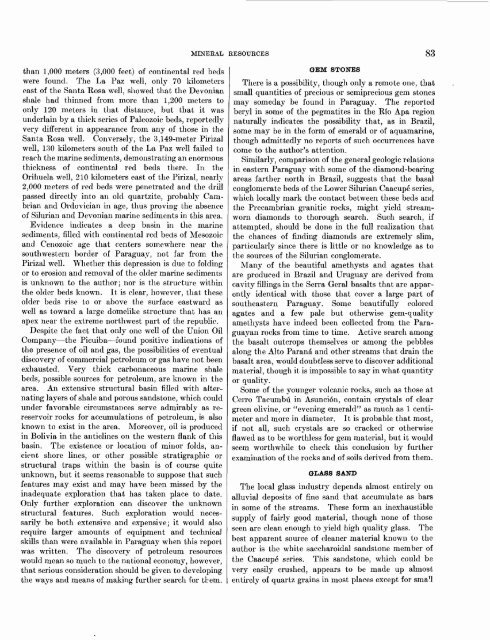Geology and Mineral Resources of Paraguay A Reconnaissance
Geology and Mineral Resources of Paraguay A Reconnaissance
Geology and Mineral Resources of Paraguay A Reconnaissance
- No tags were found...
Create successful ePaper yourself
Turn your PDF publications into a flip-book with our unique Google optimized e-Paper software.
MINERAL RESOURCES 83than 1,000 meters (3,000 feet) <strong>of</strong> continental red bedswere found. The La Paz well, only 70 kilometerseast <strong>of</strong> the Santa Rosa well, showed that the Devonianshale had thinned from more than 1,200 meters toonly 120 meters in that distance, but that it wasunderlain by a thick series <strong>of</strong> Paleozoic beds, reportedlyvery different in appearance from, any <strong>of</strong> those in theSanta Rosa well. Conversely, the 3,149-meter Pirizalwell, 130 kilometers south <strong>of</strong> the La Paz well failed toreach the marine sediments, demonstrating an enormousthickness <strong>of</strong> continental red beds there. In theOrihuela well, 210 kilometers east <strong>of</strong> the Pirizal, nearly2,000 meters <strong>of</strong> red beds were penetrated <strong>and</strong> the drillpassed directly into an old quartzite, probably Cambrian<strong>and</strong> Ordovician in age, thus proving the absence<strong>of</strong> Silurian <strong>and</strong> Devonian marine sediments in this area.Evidence indicates a deep basin in the marinesediments, filled with continental red beds <strong>of</strong> Mesozoic<strong>and</strong> Cenozoic age that centers somewhere near thesouthwestern border <strong>of</strong> <strong>Paraguay</strong>, not far from, thePirizal well. Whether this depression is due to foldingor to erosion <strong>and</strong> removal <strong>of</strong> the older marine sedimentsis unknown to the author; nor is the structure withinthe older beds known. It is clear, however, that theseolder beds rise to or above the surface eastward aswell as toward a large domelike structure that has anapex near the extrem.e northwest part <strong>of</strong> the republic.Despite the fact that only one well <strong>of</strong> the Union OilCompany the Picuiba found positive indications <strong>of</strong>the presence <strong>of</strong> oil <strong>and</strong> gas, the possibilities <strong>of</strong> eventualdiscovery <strong>of</strong> commercial petroleum or gas have not beenexhausted. Very thick carbonaceous marine shalebeds, possible sources for petroleum, are known in thearea. An extensive structural basin filled with alternatinglayers <strong>of</strong> shale <strong>and</strong> porous s<strong>and</strong>stone, which couldunder favorable circumstances serve admirably as rereservoirrocks for accumulations <strong>of</strong> petroleum, is alsoknown to exist in the area. Moreover, oil is producedin Bolivia in the anticlines on the western flank <strong>of</strong> thisbasin. The existence or location <strong>of</strong> minor folds, ancientshore lines, or other possible stratigraphic orstructural traps within the basin is <strong>of</strong> course quiteunknown, but it seems reasonable to suppose that suchfeatures may exist <strong>and</strong> may have been missed by theinadequate exploration that has taken place to date.Only further exploration can discover the unknownstructural features. Such exploration would necessarilybe both extensive <strong>and</strong> expensive; it would alsorequire larger amounts <strong>of</strong> equipment <strong>and</strong> technicalskills than were available in <strong>Paraguay</strong> when this reportwas written. The discovery <strong>of</strong> petroleum resourceswould mean so much to the national economy, however,that serious consideration should be given to developingthe ways <strong>and</strong> means <strong>of</strong> making further search for them.GEM STONESThere is a possibility, though only a remote one, thatsmall quantities <strong>of</strong> precious or semiprecious gem stonesmay someday be found in <strong>Paraguay</strong>. The reportedberyl in some <strong>of</strong> the pegmatites in the Rio Apa regionnaturally indicates the possibility that, as in Brazil,some may be in the form <strong>of</strong> emerald or <strong>of</strong> aquamarine,though admittedly no reports <strong>of</strong> such occurrences havecome to the author's attention.Similarly, comparison <strong>of</strong> the general geologic relationsin eastern <strong>Paraguay</strong> with some <strong>of</strong> the diamond-bearingareas farther north in Brazil, suggests that the basalconglomerate beds <strong>of</strong> the Lower Silurian Caacupe series,which locally mark the contact between these beds <strong>and</strong>the Precambrian granitic rocks, might yield streamworndiamonds to thorough search. Such search, ifattempted, should be done in the full realization thatthe chances <strong>of</strong> finding diamonds are extremely slim,particularly since there is little or no knowledge as tothe sources <strong>of</strong> the Silurian conglomerate.Many <strong>of</strong> the beautiful amethysts <strong>and</strong> agates thatare produced in Brazil <strong>and</strong> Uruguay are derived fromcavity fillings in the Serra Geral basalts that are apparentlyidentical with those that cover a large part <strong>of</strong>southeastern <strong>Paraguay</strong>. Some beautifully coloredagates <strong>and</strong> a few pale but otherwise gem-qualityamethysts have indeed been collected from the Paraguayan rocks from time to time. Active search amongthe basalt outcrops themselves or among the pebblesalong the Alto Parana <strong>and</strong> other streams that drain thebasalt area, would doubtless serve to discover additionalmaterial, though it is impossible to say in what quantityor quality.Some <strong>of</strong> the younger volcanic rocks, such as those atCerro Tacumbii in Asuncion, contain crystals <strong>of</strong> cleargreen olivine, or "evening emerald" as much as 1 centimeter <strong>and</strong> more in diameter. It is probable that most,if not all, such crystals are so cracked or otherwiseflawed as to be worthless for gem material, but it wouldseem worthwhile to check this conclusion by furtherexamination <strong>of</strong> the rocks <strong>and</strong> <strong>of</strong> soils derived from them.GLASS SANDThe local glass industry depends almost entirely onalluvial deposits <strong>of</strong> fine s<strong>and</strong> that accumulate as barsin some <strong>of</strong> the streams. These form an inexhaustiblesupply <strong>of</strong> fairly good material, though none <strong>of</strong> thoseseen are clean enough to yield high quality glass. Thebest apparent source <strong>of</strong> cleaner material known to theauthor is the white saccharoidal s<strong>and</strong>stone member <strong>of</strong>the Caacupe series. This s<strong>and</strong>stone, which could bevery easily crushed, appears to be made up almostentirely <strong>of</strong> quartz grains in most places except for sma1 !
















